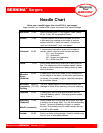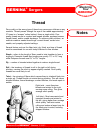
Mastering
Your
BERNINA
®
BERNINA
®
Sergers
MASTERING YOUR BERNINA
®
SERGERS 2/15/03 8
©2003 BERNINA® of America, Inc. Permission to copy granted only to Authorized BERNINA
®
Dealers
Thread
Poor quality or the wrong type of thread can cause poor stitches on any
machine. Thread passes through the eye of the needle approximately
37 times in a “seesaw” action before it forms a single stitch. Poor
quality thread results in crooked and looped stitches, puckered seams,
frayed thread, and/or needle breakage. To achieve quality stitches, an
overlock machine needs three things: correct thread, correct size
needle, and properly adjusted settings.
Several factors such as the fiber, twist, ply, finish, and size of thread
must be considered for use with today’s fabrics for fine stitches.
Staple – refers to the length of fibers used to twist together to form a
single ply. Domestic thread fiber lengths are usually 1½” to 2½” long
while European threads use 5½” to 6½” lengths.
Ply – number of strands twisted together to make a single thread.
Roll – the tendency of thread to roll to the right or left during
stitching, causing the stitch to appear slightly crooked. Poor quality
threads are more likely to roll.
Twist – the crimping of fibers which causes them to interlock firmly into
a single ply. Thread should not untwist during stitching. This will cause
skipped stitches, thread breakage, crooked stitches, and weak spots in
seams.
Right twist – most American
threads are twisted to the right,
causing some rolling. This gives
average stitch quality.
Left twist – Most commercial and
imported threads are twisted to
the left, giving better than average
stitch quality. Left twist resists
rolling and makes a larger loop for
the hook point to enter, reducing
skipped stitches.
Notes


















